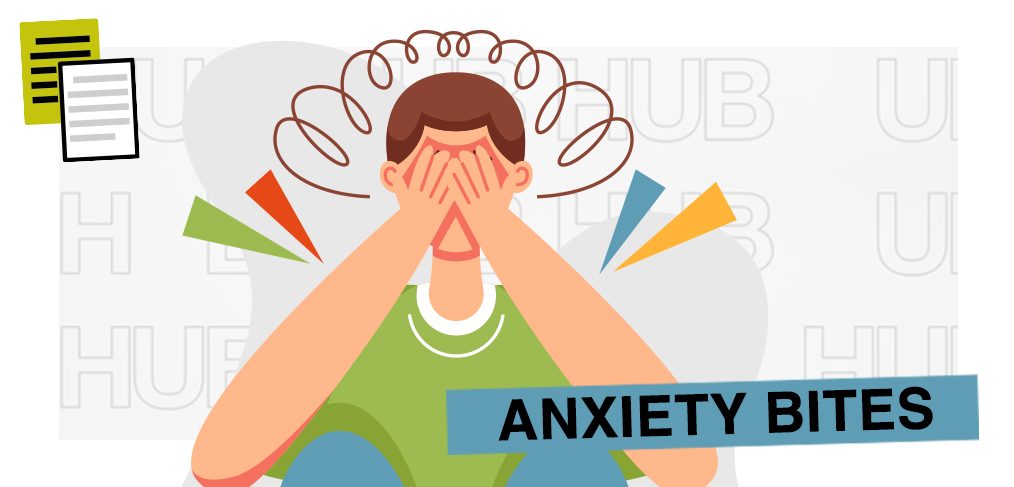
Anxiety bites
May puts Mental Health Awareness in the spotlight, with a whole week dedicated to anxiety (15-21 May). And the HUB’s here for it, providing expert insight, personal experience, and a whole load of tips and tools to help manage anxiety at work
Most people will feel anxious at some point in their life, as they go through very normal experiences, such sitting an exam or starting a new job. Anxiety commonly strikes, too, at times of change or uncertainty, during relationship struggles or over concerns about money and bills. Typical symptoms include feelings of unease, worry or fear… bad enough, right? But when anxiety hits hard, it can be utterly debilitating. In such cases, the body’s natural responses to stress exceed healthy levels and feelings of absolute terror can be experienced quickly, and often endure, affecting a person’s ability to carry out everyday tasks.
Google ‘anxiety’ and you’ll see it’s linked to many conditions, including obsessive compulsive disorder, social phobia, and post-traumatic stress disorder, but there’s also a specific condition called generalised anxiety disorder (GAD), where those suffering will feel anxious most days, about several different situations, rather than just one. According to nhs.uk, symptoms of GAD manifest not only psychologically (mentally) – for example, as heightened worry or fear, but also physiologically (physically) – for example, as dizziness, heart palpitations, or insomnia. And it can all have a knock-on effect on a person’s health, wellbeing, and ability to work.
“Anxiety is actually a completely normal experience when it’s doing the job it’s supposed to be doing – keeping you safe,” says mind and movement coach and GAD sufferer, Beth Fuller. “But when you’re feeling anxious all the time, it’s less good for your body, not to mention exhausting for your brain”.
When anxiety peaks to the point at which it has a serious impact on a person’s daily life, then it’s time to seek medical advice. But whether experienced mildly or severely, there’s no getting around it: anxiety can bite anybody, at any time. So it’s time to tackle it, head on. L’Oréal Professionnel Paris is doing exactly that. Following a three-year social listening project analysing millions of conversations and comments posted on digital platforms, and a survey carried out in seven countries involving 1,750 hair professionals, the brand recently revealed mental health comes out on top as the number one challenge facing hairdressers, with stress and anxiety at work by far the biggest talking point. In direct response, this summer, it launches Head Up – a program brought to life alongside the National Alliance on Mental Illness, to support and provide resources to the hairdressing community.
Look out for that toolkit when it arrives, but meanwhile, don’t burry your head in the sand, implores trained psychotherapist and former hairdresser, Hayley Jepson – AKA ‘The Resilient Hairdresser’. “Taking care of a team’s mental health is now very much part of the job description, which is tough for salon owners,” says Hayley, who provides training for hairdressers around burn-out and stress. “Salon owners need to understand anxiety and other mental health issues. We’re a people business, and when our people are struggling, the business is struggling. We’ve got to take care of our people.”
Taking the right kind of care has certainly paid off for Leanne Donaghy, general manager at Andrew Mulvenna Hair in Belfast. “Over the years we have experienced staff members suffering both anxiety and stress, who feel like they can no longer work in a busy salon and that their only option is to leave, even when it is clear they don’t want to,” she explains. “It has given me unbelievable job satisfaction to be able to engage in open and supportive conversations, and offer the support and assistance they need to remain in the business.”
And on that positive note, let’s get to it. Thanks to generous insight shared by hair, beauty and business owners, experts and coaches, here’s the HUB’s guide to managing and supporting anxiety in the workplace.
ANXIETY – SEVEN SIGNS TO SPOT
It’s not always easy to spot the signs of anxiety, and we are good at ‘putting a lid’ on how we’re feeling. So how will you know if a staff member is suffering? Jo Irving suggests looking out for the following…
1) The person being easily scared or jumpy. This is often a sign that the person’s fight or flight response is kicking in, so anything above that can cause what looks like a big overreaction to something that makes them jump
2) A change in personality, maybe they’re not as playful or relaxed as usual?
3) Not talking as much or talking much more than usual
4) Massively over thinking normal situations or having difficulty making decisions
5) Crying or quickly getting angry or frustrated
6) Showing signs of self-doubt, saying sorry a lot and assuming they are in the wrong
7) If someone is experiencing anxiety you will often notice they are breathing louder or taking large intakes of air, as sufferers often feel they can’t catch their breath as their heart beats faster
Anxiety bites: read the case studies >
Create a culture where it’s okay to open up
Making sure your staff members know they can talk to you, and taking the time to listen to them, is probably the most important first step in managing anxiety in the workplace. Carla Zebrowksi is manager at Ego Hair Design in Inverness, and CEO of salon marketing firm, Salon Jedi, and regularly educates businesses in mental health awareness and management. “Create an environment that feels safe and supportive”, says Carla. “This can be achieved by setting clear expectations for behaviour and communication, encouraging open and honest dialogue, and promoting a culture of kindness and empathy.”
The owner of Glasgow’s Roar Hair & Beauty salon group, Brian Leo McCallum, agrees. “You really need a support system in place for team members to feel comfortable to talk to their bosses, management, and each other, if they feel comfortable enough to do so,” he says. “We encourage open communication as well as private spaces to talk to each other, regardless of roles held.” And while Emma Marcey, founder of Odd in Limerick, has done a lot to try to combat anxiety in the workplace – including switching to a four-day week, ensuring adequate breaks are taken, and providing fair pay and holidays, she’s adamant prevention is the best cure, and that starts with “a healthy company culture, a strong clear code of ethics, and an open-door policy.”
Communication is a huge part of the culture at YOKE THE SALON in Plymouth. Co-owners Jo and Steve Dyer talk to their team daily and as such, can quickly identify the onset of anxiety. There’s no traditional hierarchy in place, either, which, they believe, emboldens team members to open up to one another, too. “The entire team is very aware of each other’s feelings and is constantly looking out for each other,” says Jo. “We also talk to those we know are close to a team member, who we feel needs love and support. And we encourage everybody to activate the free counselling sessions we have set up for them, whenever they need them.”
Trust plays a key role in fostering a culture centred not only around openness but around honestly, too. If we’re confident to speak truthfully about how we’re feeling, and to seek help when we need it, then we’re more likely to gain and to grow as human beings. “I’ve talked openly about the importance of being honest with my team, and vice versa, about how we’re feeling, at all times, and without judgement,” says Bloggs Salons owner Joe Hemmings, for L’Oréal Professionnel Paris. “My team trusts me, and I trust them, and this means we can get through situations together by talking honestly and supporting each other.”
But while it may be your responsibility to protect the wellbeing of your staff, remember, it’s not your job to fix someone’s problems. “You are here to help provide support, so that your team can grow in an authentic way and feel proud of the journey,” says salon owner and ICF qualified life and business coach, Jo Irving. “It’s about creating the right culture, being open and honest and developing an environment where we speak openly about how everyone is doing.”
Lesley Blair MBE is CEO and chairperson at the British Association of Beauty Therapy & Cosmetology and the Confederation of International Beauty Therapy & Cosmetology, and believes it’s vital for employers to recognise the importance of adopting a holistic approach to their company’s welfare. “Taking your team’s wellbeing seriously not only promotes an inclusive, healthy, and happy working environment, but also safeguards staff retention and improves productivity,” she says. “This in turn bolsters the success of the business and the employer’s personal wellbeing.”
And that’s proved to be the case for salon owner, educator and mentor, Cally Borg – AKA ‘The Lifestyle Hairstylist’, ‘who has put wellbeing at the heart of her business culture, implementing strategies to evade overwork and burnout. “I believe in the four-day work week – I feel it’s essential for me and my staff to have a healthy work-life balance,” she says. “None of my team works evenings or weekends, and I’ve set a rota that means my staff get a four-day weekend, every other week. Everybody works hard in the salon, and they deserve a break. And what happens when they get one? They come back refreshed and ready to go!”
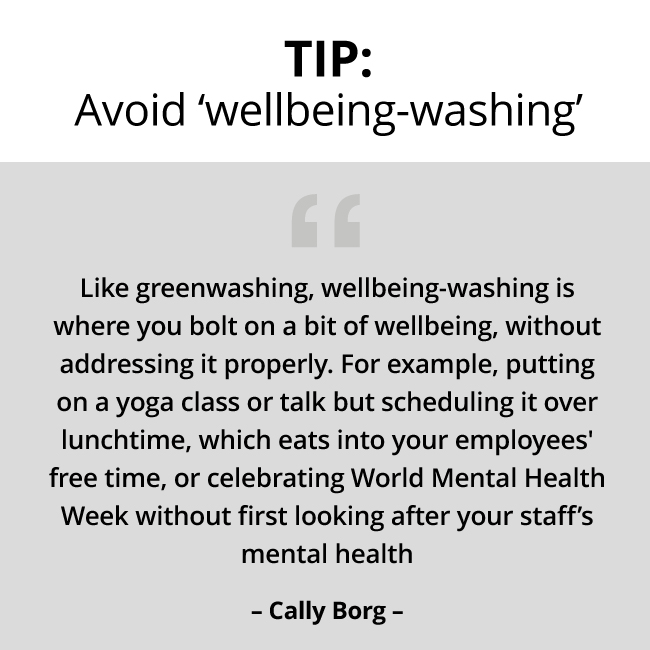
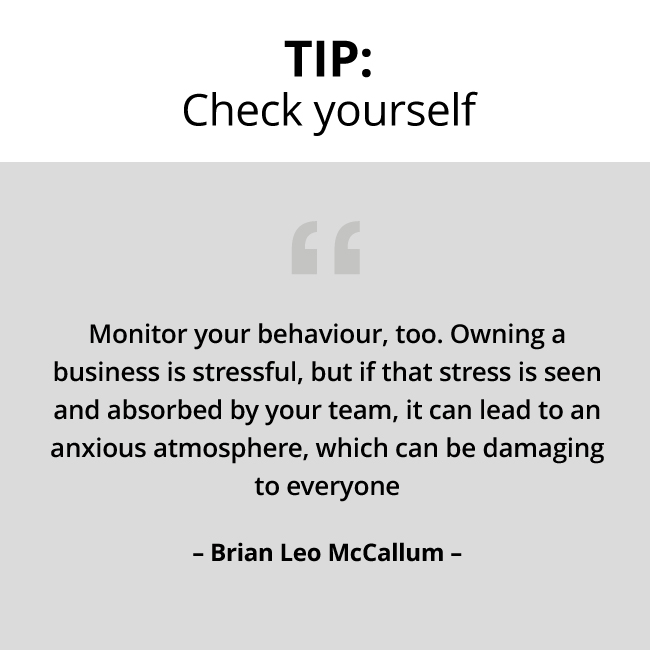
Anxiety bites: read the case studies >
Initiating conversation with an anxious team member
When you recognise a team member is struggling and you want to offer help and support, the most important thing to do is listen. But remember, advises Hayley Jepson, “they may not want to talk, and they don’t have to. What you want them to recognise is that you are simply trying to make things better or easier for them at work. That needs to be the clear focus of the conversation.”
The way you initiate a conversation, or rather, create an opportunity for the anxiety sufferer to talk to you, is just as important as the privacy – and the safe space – you afford them. Be careful with your choice or words. Says Jo Irving: “Saying ‘can I have a word’ may cause worry,” – the very symptom you’re trying to appease. “If you’re going to broach the subject then make sure you keep it casual and light and your voice soft. Where possible, I would take the person to the side and let them know you are there for them and that they are safe. Simply asking ‘how are you feeling today?’ is a great start.”
Laura Leigh Kerr, director of Rainbow Room International Academy, believes we can overthink ‘the conversation’, concerned about saying the wrong thing. But in reality, the right approach is to say less and listen more. “Use open questions and mirror body language, says Laura Leigh. “Don’t be judgmental or give opinions and try to avoid too much eye contact. The person needs to feel at ease and know they are in a safe, confidential space. And, when they’ve finished speaking, summarise what they have told you. This is the point where you make a call on whether to dig deeper – and 99 per cent of the time I always do. I would rather the person is frustrated I am fussing over them, than the possible consequences of not asking more questions.”
A different approach might be first to ask your team member to do something simple, and which doesn’t involve much thought – creating an easy win. Jo Iving explains: “When they have succeeded at something and are feeling good, you can take the opportunity to remind them that they are in a supportive working environment. Then, instead of saying ‘what’s going on?’ or ‘is there anything I can do at work to make things easier for you?’, you can say something like, ‘I just want to let you know we want you to be happy and feel good while you’re at work; it’s important to me you’re feeling your best, so if anything comes up, let’s have a chat’. Zero judgement and totally confidential.”
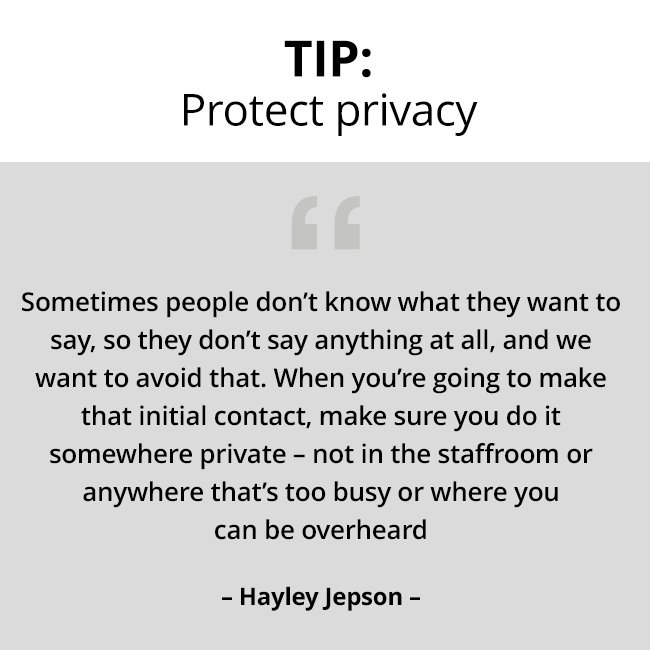
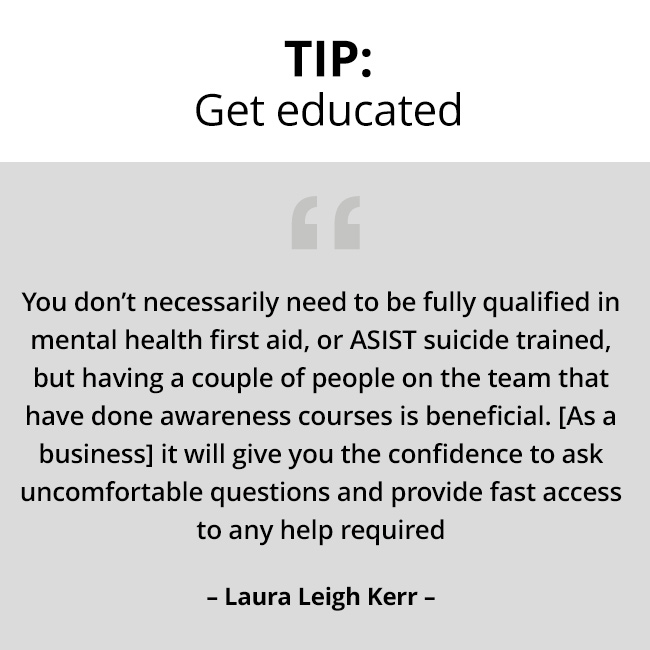
STEPS TO TAKE WHEN ANXIETY STRIKES
Barbara Khattri, owner of Elements Lifestyle Salon, believes a happy and successful team is a supported team and recognises the impact anxiety can have on her staff, daily. When feelings of anxiety strike, and you’re in the middle of a work task, try some of Barbara’s coping mechanisms:
When you’re with a client and can’t step away:
- Blow it away… Gently and slowly fully exhale through your mouth, then inhale through your nose while silently chanting ‘OM’ in your head
- Make like a statue… Stand still, or as close as you can to still, for, say 30 seconds, and lift your chest slightly, just a centimetre even will help
- Be present …Engage your senses in the moment, focus your eyes on one thing at a time, become aware of the feel of your work tools, and connect with just one sound in the salon
When you can step into the team room or outside:
- Breathe… Practise alternate nostril breathing for one minute
- Warm up… Enjoy a hot ginger tea or get warm by running your wrists under warm water or putting on an extra layer
- Connect … with a team member or journal your thoughts
Anxiety bites: read the case studies >
Effecting mental respite and physical distractions
Self-care is a big part of personal wellbeing and making time for us – whether that’s taking a day off, a bath, or simply five minutes of quiet – can go a long way in maintaining a healthy mental state. For anxiety sufferers, and especially when anxiety bites, this is even more important, as is the ability and the workplace flexibility, to step away from a triggering or high-stress moment.
Carla Zebrowski suggests encouraging your team to take breaks when they need them, even if that’s just two minutes outside in the fresh air. And that goes for you, too! “Engage in activities that help you to relax and de-stress – walking, reading, going to the gym,” she says. “Meditation isn’t always about sitting crossed legged and deep breathing. If you enjoy cycling and switch off when you do, then that is a form of relaxation and meditation. Also, listening to your favourite music can change your spiritual energy state from low vibration [associated with negative emotions] to high vibration [associated with happiness and positivity].”
Beth Fuller confesses to have pinched her favourite anxiety management tip from a comedian. “Talk to yourself like you are a beloved pet,” she says. “When you’re not feeling quite right, try asking yourself, in that kind, loving voice reserved for your pet, ‘what it is that you need?’, ‘is your blood sugar low?’, ‘do you need to sit down?’. Honestly, as daft as it sounds, what it’s doing is allowing you to check in with your body (anxiety is a chemical thing) and giving you a second to slow down. It also reminds you that you’re loved and safe – that’s why the tone of how you’re talking to yourself is important.”
“If that doesn’t quite float your boat, another brilliant technique is to breathe out deeply, perhaps adding the mantra, ‘I am safe’,” continues Beth. “You don’t want to take a big inhale first, because that suggests to your body that the anxiety is an actual threat and you’re getting ready to run away. Just take a normal inhale and exhale really slowly. This signals to the body that you’re safe.”
Understanding the positive impact of controlled breathing is invaluable, and it’s something we can practice and pass on to others in times of anxiety. “During a coffee break, it’s helpful to go back to basics and do a short breathing exercise to help ease any overwhelming and panicked feelings that creep in,” says Georgina East, director and skin transformation expert at Grafton Spa & Wellness.
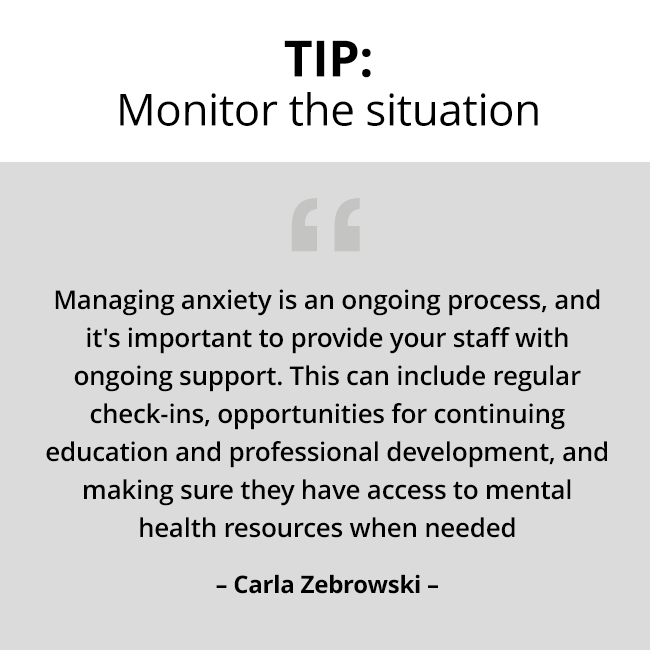
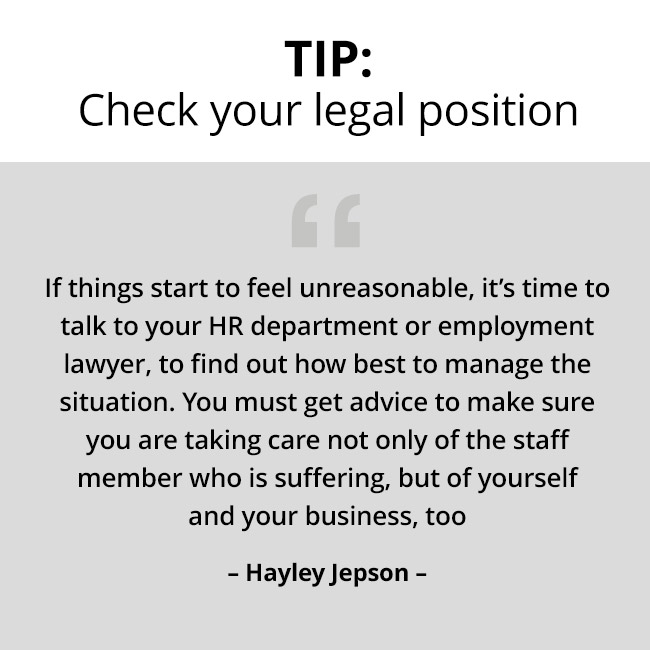
It feels we’ve merely scratched the surface of this important subject, but hopefully this piece has painted a clearer picture of what anxiety is, how it presents and ways to manage it. For more insight and first person experience, hear from five salon and barbershop business leaders in ‘Anxiety bites: the case studies’. And please email the HUB if you’ve got an opinion to share.
To conclude, a final word from Beth Fuller: “The more we talk about anxiety the better. Even the people who look super shiny and happy can have those debilitating thoughts, so look after those ones as well”.
• • •
Helpful links:
Generalised anxiety order (GAD) – NHS overview >
Mental Health: Workplace First Aider course – St John Ambulance >
Mental Health Awareness Week 2023 – Mental Health Foundation >
Mental Health First Aid course – MHFA England >
The Resilient Hairdresser – mental health for the hair industry >
Salon Jedi – training and events for salon owners and managers >
Beth Fuller Wellness – mind and movement coaching >
The Lifestyle Hairstylist – mentoring >
Spill – employee mental health support >
